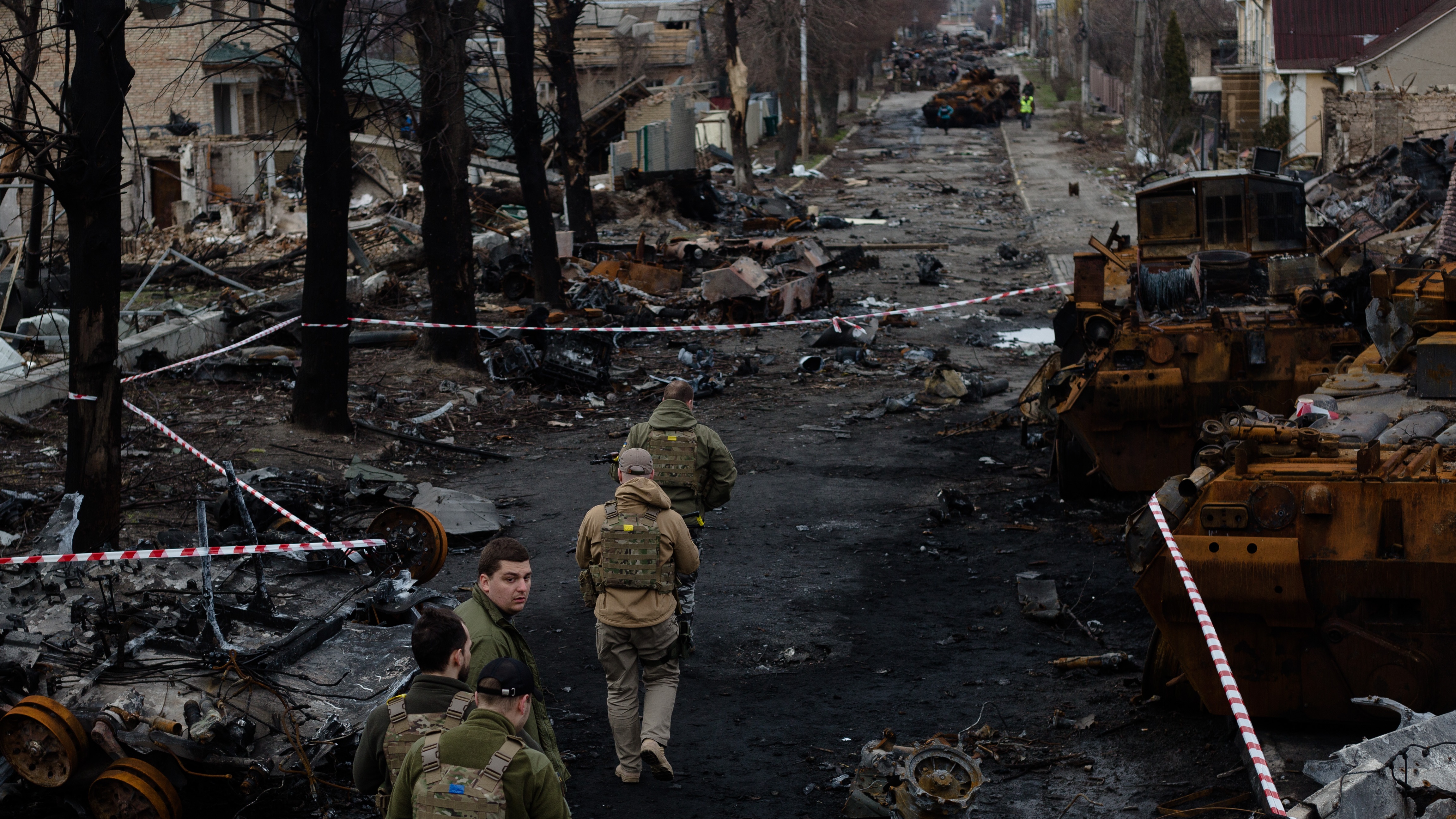What are fléchettes and are they evidence of Russian war crimes?
Metal darts discovered by forensic doctors in bodies in Bucha mass graves

Civilians who died during the Russian invasion of the Ukrainian town of Bucha were killed by small metal arrows fired by artillery, forensic doctors have said.
Known as fléchettes, The Guardian said the dart-shaped weapons have been found “embedded in people’s heads and chests” by pathologists and coroners who are carrying out post-mortems on the bodies found in mass graves in the region north of Kyiv.
“We found several really thin, nail-like objects in the bodies of men and women and so did others of my colleagues in the region,” Vladyslav Pirovskyi, a Ukrainian forensic doctor, told the paper. “It is very hard to find those in the body, they are too thin. The majority of these bodies come from the Bucha-Irpin region.”
The Week
Escape your echo chamber. Get the facts behind the news, plus analysis from multiple perspectives.

Sign up for The Week's Free Newsletters
From our morning news briefing to a weekly Good News Newsletter, get the best of The Week delivered directly to your inbox.
From our morning news briefing to a weekly Good News Newsletter, get the best of The Week delivered directly to your inbox.
‘Anti-personnel weapon’
Independent experts who reviewed images of the arrows retrieved from bodies in Bucha confirmed to The Guardian that they are fléchettes, French for “little darts”, an “anti-personnel weapon” used extensively during the First World War.
The “metal darts are contained in tank or field gun shells”, each of which “can contain up to 8,000 fléchettes”, the paper reported. “Once fired, shells burst when a timed fuse detonates and explodes above the ground”, spraying the arrows in all directions.
The area covered by a single shell can be the equivalent of “three football fields” in width, The Washington Post said. The shells are “primed to explode over infantry formations and spew projectiles in a conical pattern”.
According to The Economist, fléchettes were “invented in Italy in the early 1900s and adopted by all sides” during the First World War. The arrows “were typically 12cm long with fins for stability and were dropped from aircraft in canisters of tens or hundreds”.
A free daily email with the biggest news stories of the day – and the best features from TheWeek.com
“America then developed a new, more lethal generation in the 1950s, in a programme codenamed Lazy Dog,” the paper continued. The new and improved weapon “struck with the force of a bullet” and “had a good chance of killing anyone in the area”.
The US deployed this new generation of fléchettes during the Vietnam War, where “gruesome” and “apocryphal stories told of victims found nailed to trees”.
They are now “rarely used in modern warfare, other than periodically by the Israel Defence Forces (IDF)”, The Guardian said. The IDF has “deployed them in military operations in Lebanon and the Gaza Strip, killing and wounding civilians”.
Their use made headlines in March 2008, when a Palestinian journalist with Reuters, Fadel Shana, was killed by fléchettes fired by an Israeli tank.
Svitlana Chmut, a resident of Bucha, told The Washington Post that she found several fléchettes nailed to her car following the Russian invasion. “If you look closely on the ground around my house, you will find a lot more of them,” she said.
War crimes
“Human rights groups have long sought a ban on fléchette shells”, The Guardian said, but they “are not prohibited under international law”. However, “the use of imprecise lethal weapons in densely populated civilian areas is a violation of humanitarian law”.
A spokesperson for Amnesty International said the weapons “should never be used in built-up civilian areas”, while Neil Gibson, a weapons expert at the UK-based Fenix Insight group, told the paper that they are an “uncommon and rarely seen projectile”.
Bucha’s mayor, Anatoliy Fedoruk, said: “You don’t have to be an arms expert to understand that Russia ignored the rules of war in Bucha. Bucha was turned into a Chechen safari, where they used landmines against civilians.”
They “kill and maim indiscriminately”, The Economist said, raising questions about how Russia would justify their deployment in a densely populated area.
Moscow “might have issued small numbers of flechette rounds for defensive purposes”, though it is “also possible the aim was simply to terrorise”.
-
 Venezuela’s Trump-shaped power vacuum
Venezuela’s Trump-shaped power vacuumIN THE SPOTLIGHT The American abduction of Venezuelan President Nicolás Maduro has thrust South America’s biggest oil-producing state into uncharted geopolitical waters
-
 Most data centers are being built in the wrong climate
Most data centers are being built in the wrong climateThe explainer Data centers require substantial water and energy. But certain locations are more strained than others, mainly due to rising temperatures.
-
 ‘Maps are the ideal metaphor for our models of what the world might be’
‘Maps are the ideal metaphor for our models of what the world might be’Instant Opinion Opinion, comment and editorials of the day
-
 What will happen in 2026? Predictions and events
What will happen in 2026? Predictions and eventsIn Depth The new year could bring peace in Ukraine or war in Venezuela, as Donald Trump prepares to host a highly politicised World Cup and Nasa returns to the Moon
-
 All roads to Ukraine-Russia peace run through the Donbas
All roads to Ukraine-Russia peace run through the DonbasIN THE SPOTLIGHT Volodymyr Zelenskyy is floating a major concession on one of the thorniest issues in the complex negotiations between Ukraine and Russia
-
 US offers Ukraine NATO-like security pact, with caveats
US offers Ukraine NATO-like security pact, with caveatsSpeed Read The Trump administration has offered Ukraine security guarantees similar to those it would receive from NATO
-
 How Bulgaria’s government fell amid mass protests
How Bulgaria’s government fell amid mass protestsThe Explainer The country’s prime minister resigned as part of the fallout
-
 Europe sets 2027 deadline to wean itself from Russian gas
Europe sets 2027 deadline to wean itself from Russian gasIN THE SPOTLIGHT As negotiators attempt to end Russia’s yearslong Ukraine invasion, lawmakers across the EU agree to uncouple gas consumption from Moscow’s petrochemical infrastructure
-
 Is Europe finally taking the war to Russia?
Is Europe finally taking the war to Russia?Today's Big Question As Moscow’s drone buzzes and cyberattacks increase, European leaders are taking a more openly aggressive stance
-
 Pushing for peace: is Trump appeasing Moscow?
Pushing for peace: is Trump appeasing Moscow?In Depth European leaders succeeded in bringing themselves in from the cold and softening Moscow’s terms, but Kyiv still faces an unenviable choice
-
 Femicide: Italy’s newest crime
Femicide: Italy’s newest crimeThe Explainer Landmark law to criminalise murder of a woman as an ‘act of hatred’ or ‘subjugation’ but critics say Italy is still deeply patriarchal